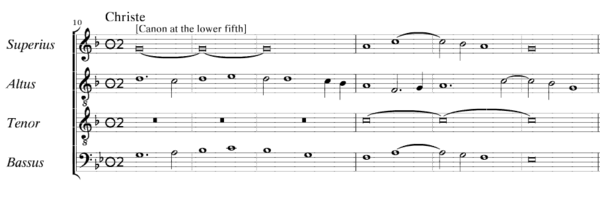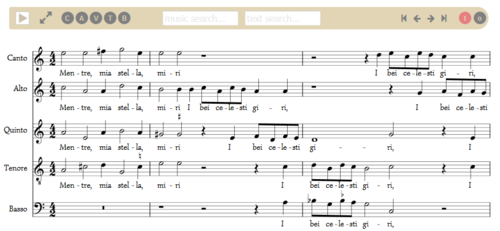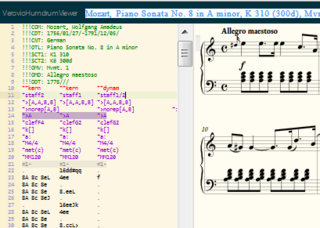Template:EVE Editable
Contents
CMME (Computerized Mensural Music Editing)
Website: CMME
The idea of CMME, conceived in 1999 as a Princeton undergraduate project by Ted Dumitrescu, was to support dynamic editions based on encoding standards comparable with the most rigorous printed editions. Editions of music in mensural notation have given rise to many changes of editorial opinion. In contrast to print, virtual editions have the possibility of being easily re-rendered to express changing views. On-screen views support the presence or absence of musica ficta and text underlay rationalized to fit the music or clustered at the start of line (as in many period manuscripts). Marnix van Berchem is the current director of the Utrecht-based project.
Digital Scores of Chopin's First Editions
Website: Digital Scores of Chopin's First Editions
The recent new edition of all of Chopin's works is available under the auspices of the Frideric Chopin Institute in Warsaw. Filters allow users to sort works by genre and publisher, find them by opus number, and search the musical content for specific intervalic and rhythmic patterns. Interfaces are available in Polish and English (chopinscores.org/en).
KernScores
Website: KernScores
KernScores is a comprehensive website of musical data for analysis. (Kern is the Common Western Notation encoding format the Humdrum ToolKit, which has its own website and data repository at Ohio State University.) KernScores emphasize piano music. A large number of analytical conversions can be run on-the-fly from the long list of links that follows each title listing. Most repertories are for keyboard. The full collection can be browsed here. (EsAC data has also been translated to the Kern format, and 1000 additional pieces have been added by Damien Sagrillo.) An online Humdrum editor enables users to add their own data and run simple analysis routines on it.
The following conversions of data to sound and notation are among those supported:
- MIDI (sound)
- MuseData (notation, editing, analysis)
- MusicXML (data interchange)
- ABC+ (notation)
- Guido (online notation)
KernScores also generates piano rolls, keyscapes, and several other kinds of analytical data.
MuseData
Website: MuseData
MuseData, based at the Center for Computer Assisted Research in the Humanities at Stanford University, refers to (1) an encoding system for music, (2) the software optimized for it, and (3) several corpora of scores encoded in the system. The representation system and software have been developed with Walter Hewlett from 1984 through the present. The basic features of the system are described in Beyond MIDI: .
The musical corpora contain more than 1,200 fully encoded works, including symphonies, string quartets, operas, oratorios, cantatas, and other kinds of works. The names of encoders and musical sources are embedded in the files together with other metadata. A large number of works have been encoded by Frances Bennion and Edmund Correia Jr. Other contributions have been made by Don Anthony, Jean-Pierre Dautrecourt, Pamela Decker, Michael Flexer, and Steven C. Rasmussen. The web interface and data conversion are principally the work of Craig Sapp (also the site manager), with contributions by David Huron and Andreas Kornstaedt.
Mensural extensions by Hewlett have been adopted by the Josquin Research Project and the Tasso Music project (online in 2016). MuseData supports conversion to MIDI, Humdrum Kern, SCORE, MusicXML, and MEI. Direct conversion from MuseData code to PDF is under development.
The following series of wikis provides PDF scores and/or performing parts generated from edited MuseData-encoded repositories. Finalized files are stored on github. Versions for editing can be downloaded from musedata.org.
MuseData: Ludwig van Beethoven
Website: Ludwig van Beethoven
Versions for editing can be downloaded from musedata.org.
MuseData: Arcangelo Corelli
Website: Arcangelo Corelli
The 72 sonatas and concertos published in Corelli's lifetime, with facsimiles, PDFs, MIDI files, and commentary.
Versions for editing can be downloaded from musedata.org.
MuseData: Georg Frideric Händel
Website: Georg Frideric Händel
Several of the newly edited works are protected by copyright. Shorter works may be downloaded from musedata.org and re-edited.
- Concerti Op. 6: score and parts
MuseData: Antonio Vivaldi
Website: Antonio Vivaldi
The digital Vivaldi repository currently includes complete editions based on early prints of the sonatas Opp. 1, 2, and 5; the concertos for violin(s) and string orchestra Opp. 4, 8, and 11, plus the "military" oratorio Juditha triumphans . Performing parts for Opp. 3, 8, 10, and Juditha triumphans are also available.
Josquin Research Project

Website: Josquin Research Project
The Josquin Research Project began as an effort to support comparative evaluations of authorship. Surviving works attributed to Josquin fall into two broad groups: those for which authorship is secure and those for which attributions to multiple composers may exist. Currently, 763 works by a total of 23 composers are included. Motets and mass sections predominate. The number of voices varies from three to six. Users can search for pitches, intervals, and rhythmic patterns in a browser. The files are available in several symbolic formats (MIDI, Humdrum, MEI, MuseData, MusicXML, MP3, and PDF). Displays with and without musica ficta are supported. Jesse Rodin is the principal investigator. Craig Sapp manages the website and tool implementations.
Tasso in Music Project

Website: Tasso in Music Project
The Tasso in Music Project, under the direction of Emiliano Ricciardi, presents all the musical settings of the poetry of Torquato Tasso (1544-1595). For the time, Tasso's work was widely distributed. It was accessible to both the learned and to ordinary people. His best known works are Aminta (1573) and Gerusalemme liberata (Jerusalem liberated, 1574), an epic focused on the First Crusade. Its numerous tales were retold in countless musical contexts, including Monteverdi's Tancredi e Clorinda and subsequent operas of the seventeenth century. Tasso's biography, which incorporated notable emotional vicissitudes, inspired later works by Liszt and Donizetti. Tasso's Rime (Rhymes) were set prolifically by Gesualdo(1566-1613) and Wert (1535-1596). The Tasso project makes both the literary texts and the music (including multiple settings of the the same text) available. The integration of critical information (sources, variants, clefs, mensuration signs) and tools for extracting text from the music are provided. Technical direction is provided by Craig Sapp. Numerous scholars contribute their expertise to the project. Alternative formats follow the model of the Josquin Research Project.
Turkish Makam Music Collection
Website: Turkish Makam Music Collection (SymbTr)
The Turkish Makam Music Symbolic Data Collection (SymbTr) is designed for analysis of encoded repertories and is currently the largest repertory of its kind. It offers 2,200 pieces from 155 makams, 88 usuls, 56 forms, about 865,000 musical notes (80 hours of nominal playback time). Makam is a system of intervalic relationships and melodic development types widely used in Turkish, Persian, and Arabic music. This set of encoded scores, based on pieces from Turkish art and folk music, is based on authoritative sources. It covers a broad historical time span among pieces which are still performed in today. Scores are available in text, MusicXML (compatible with MuseScore, Finale and Sibelius), PDF, MIDI and mu2 formats. The mu2 format is readable by the microtonal notation editor Mus2. Now available from github.
Verovio Humdrum Viewer (and Editor)
Website: Verovio Humdrum Viewer
The Verovio Humdrum Viewer (VHV) is an implementation of Verovio based on the Kern data format used by the Humdrum (Musical Analysis) Toolkit. While viewing a score produced from encoded material, a user can edit the code and see the changes immediately. By clicking an arbitrary point in the displayed score the music can also be heard. Verovio is a lightweight library for engraving MEI (Music Encoding Initiatve) scores into vector graphics for online display.)

